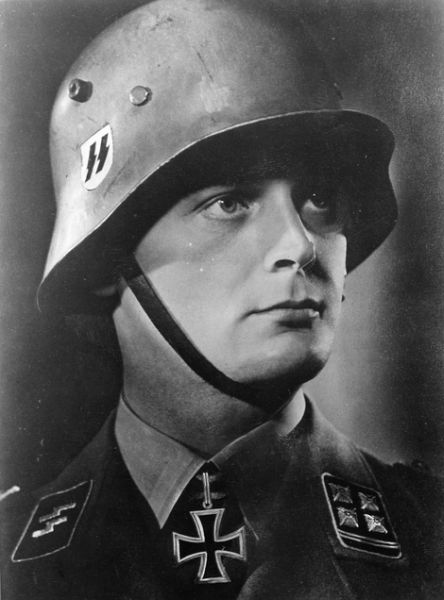Polewacz, Harry (Waffen SS)
- Date of birth:
- March 31st, 1909 (Berlin/Brandenburg, Germany)
- Date of death:
- January 12th, 1943 (Orlovskaja, near Rostov/Rostov Oblast, Soviet Union)
- Service number:
- SS-Nr.: 35.952 // NSDAP-Nr.: 89.889
- Nationality:
- German
Biography
Promotions:
01.10.1933: SS-Sturmführer
09.05.1934: SS-Obersturmführer
01.01.1935: SS-Hauptsturmführer
00.00.1940: SS-Sturmbannführer
01.09.1942: SS-Obersturmbannführer
Career:
00.00.1933: SS-Truppführer, 3. Kompanie, II. Bataillon, LAH
00.05.1933: 1. Kompanie, LAH
00.04.1934: SS-Sturmführer, Chef, Rekruten-Kompanie, LAH
00.01.1935: SS-Hstuf, Chef, 10. Kompanie, LAH
00.09.1939: SS-Hstuf, Führer, 10. Kompanie, LAH, SS-VT - campaign in Poland
00.05.1940: SS-Hstuf, Führer, 10. Kompanie, LAH, SS-VT - campaign in France
00.05.1940: sevrely WIA
00.11.1940: Führer, III. Bataillon, SS-Panzergrenadier-Regiment 9 'Germania', SS-Division (mot.) 'Wiking'
00.11.1941-00.12.1941: SS-Stubaf, Kommandeur, III. Bataillon, SS-Panzergrenadier-Regiment "Nordland", 5. SS-Division 'Wiking'
00.12.1941-00.09.1942: SS-Ostubaf, Kommandeur, I. Bataillon, SS-Panzergrenadier-Regiment "Nordland", 5. SS-Division 'Wiking'
28.09.1942-12.01.1943: SS-Ostubaf, Kdr, SS-Panzergrenadier-Regiment 10 'Westland', 5. SS-Panzer-Division 'Wiking'
12.01.1943: SS-Ostubaf, Kdr, SS-Panzergrenadier-Regiment 10 'Westland', 5. SS-Panzer-Division 'Wiking', KIA by a Russian sniper near Orlovskaja, Rostov
Do you have more information about this person? Inform us!
- Period:
- Second World War (1939-1945)
- Rank:
- SS-Hauptsturmführer (Captain)
- Unit:
- Führer, 10. Kompanie, LAH, SS-VT
- Awarded on:
- September 8th, 1939
- Period:
- Second World War (1939-1945)
- Rank:
- SS-Hauptsturmführer (Captain)
- Unit:
- Führer, 10. Kompanie, LAH, SS-VT
- Awarded on:
- May 28th, 1940
- Period:
- Second World War (1939-1945)
- Rank:
- SS-Hauptsturmführer (Captain)
- Unit:
- Führer, 10. Kompanie, LAH, SS-VT
- Awarded on:
- June 5th, 1940
- Period:
- Second World War (1939-1945)
- Rank:
- SS-Sturmbannführer (Major)
- Unit:
- Führer, I. Bataillon, SS-Infanterie-Regiment Nordland, 5. SS-Panzer-Division "Wiking", Waffen-SS
- Awarded on:
- December 19th, 1941
- Period:
- Second World War (1939-1945)
- Rank:
- SS-Sturmbannführer (Major)
- Awarded on:
- January 11th, 1942
- Period:
- Second World War (1939-1945)
- Awarded on:
- January 30th, 1942
- Period:
- Second World War (1939-1945)
- Awarded on:
- September 10th, 1942
- Period:
- Second World War (1939-1945)
- Rank:
- SS-Sturmbannführer (Major)
- Unit:
- Kommandeur, III. Bataillon, SS-Panzergrenadier-Regiment Nordland, 5. SS-Panzer-Division "Wiking", Waffen-SS
- Awarded on:
- December 23rd, 1942
“At the end of September the SS-Division Wiking (which had just arrived in the operations area of 1. Pz.Armee) was issued a new combat mission. It was to break out from the Terek bridgehead, force a breakthrough of the enemy positions at the anti-tank ditch east of Nishni Kurp and carry on advancing beyond that point to Ssagopshin.
The SS I.R. Nordland was placed at the Division’s point of main effort, and its subordinate I./SS I.R. Nordland was tasked with capturing the deeply echeloned enemy defenses at the northern part of the anti-tank ditch. This would lay the groundwork for the rest of the Division to continue on eastwards.
On the morning of the 26.09.1942 SS-Obersturmbannführer Polewacz and his I./SS I.R. Nordland (reinforced by a StuG-Batterie) moved out against the enemy positions under the cover of morning mist.
The enemy (the 57th Rifle Brigade) put up bitter resistance. The mist cleared, and the foe was thus given the chance to plaster the I./SS I.R. Nordland with coordinated fire as it advanced over open ground. Bitter close combat had already erupted at several locations.
Within a short time the commander of 1. Kompanie and the commander of the StuG-Batterie had fallen, and the losses in men were also mounting. The replacement commander of 1. Kompanie was also badly wounded before long.
The hard-pressed 3. Kompanie (deployed on the right wing of the Bataillon) received strong flanking fire from the southern part of the anti-tank ditch, and its commander also fell. The Ordonnanz-Offizier of the Bataillon was sent to take his place, but after an hour he also became badly wounded. The Bataillon adjutant then took over command of the Kompanie.
The Bataillon bogged down in the strong defensive and flanking fire as it fought both in and just before the enemy positions.
SS-Obersturmbannführer Polewacz recognized this critical situation, and so (under heavy opposing fire) he rushed to the right attacking Kompanie in order to personally reorganize and redirect it. He then moved to the left wing Kompanie (pinned down in enemy positions at the time), took command over it and stormed the main enemy positions at the head of this unit. The entire Bataillon was inspired by his actions, and the men followed suit.
In this hard battle SS-Obersturmbannführer Polewacz was an example of the highest bravery for his men. It was his personal actions in this critical situation that enabled the penetration and breakthrough of the deep enemy defenses along the anti-tank ditch to succeed.
Because of this the SS Division Wiking was able to send in additional forces to carry on eastwards from this breakthrough point on the very same day.
The Regiment is thus submitting a request for the award of the Knight’s Cross to the Iron Cross for SS-Obersturmbannführer Polewacz on account of his actions on the 26.09.1942. His personal bravery and initiative on this day led to a success that was of decisive importance for the Division’s conduct of the battle.”
- Period:
- Second World War (1939-1945)
- Period:
- Second World War (1939-1945)
- Period:
- Second World War (1939-1945)
- Period:
- Second World War (1939-1945)
- Period:
- Second World War (1939-1945)
Sources
- Photo 1: Igor Poul
- - FELLGIEBEL, W.P., Elite of theThird Reich, Helion & Company Limited, Solihull, 2003.
- MOONEY, PETER, Waffen-SS Knights and their Battles, Schiffer Pub Ltd, 2008.
- PATZWALL, K. & SCHERZER, V., Das Deutsche Kreuz 1941-1945, Band II, Verlag Klaus D. Patzwall, Norderstedt, 2001.
- Die Ordensträger der Deutschen Wehrmacht (CD), VMD-Verlag GmbH, Osnabrück, 2002
- SS-Dienstalterliste, Stand vom Oktober 1934
- Die Träger des Ritterkreuzes des Eisernen Kreuzes 1939-1945
- Microfilm Publication A3343. US National Archives




















